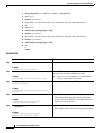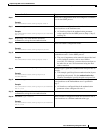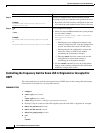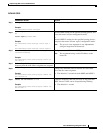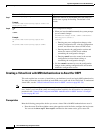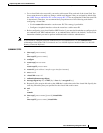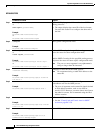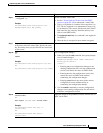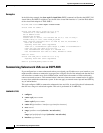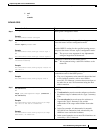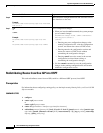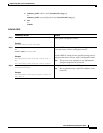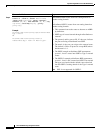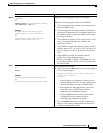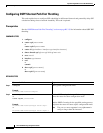
Implementing OSPF on Cisco IOS XR Software
How to Implement OSPF on Cisco IOS XR Software
RC-164
Cisco IOS XR Routing Configuration Guide
Examples
In the following example, the show ospfv3 virtual links EXEC command verifies that the OSPF_VL0
virtual link to the OSPFv3 neighbor is up, the ID of the virtual link interface is 2, and the IPv6 address
of the virtual link endpoint is 2003:3000::1.
RP/0/RP0/CPU0:router# show ospfv3 virtual-links
Virtual Links for OSPFv3 1
Virtual Link OSPF_VL0 to router 10.0.0.3 is up
Interface ID 2, IPv6 address 2003:3000::1
Run as demand circuit
DoNotAge LSA allowed.
Transit area 0.1.20.255, via interface POS 0/1/0/1, Cost of using 2
Transmit Delay is 5 sec, State POINT_TO_POINT,
Timer intervals configured, Hello 10, Dead 40, Wait 40, Retransmit 5
Hello due in 00:00:02
Adjacency State FULL (Hello suppressed)
Index 0/2/3, retransmission queue length 0, number of retransmission 1
First 0(0)/0(0)/0(0) Next 0(0)/0(0)/0(0)
Last retransmission scan length is 1, maximum is 1
Last retransmission scan time is 0 msec, maximum is 0 msec
Check for lines:
Virtual Link OSPF_VL0 to router 10.0.0.3 is up
Adjacency State FULL (Hello suppressed)
State is up and Adjacency State is FULL
Summarizing Subnetwork LSAs on an OSPF ABR
If you configured two or more subnetworks when you assigned your IP addresses to your interfaces, you
might want the software to summarize (aggregate) into a single LSA all of the subnetworks that the local
area advertises to another area. Such summarization would reduce the number of LSAs and thereby
conserve network resources. This summarization is known as interarea route summarization. It applies
to routes from within the autonomous system. It does not apply to external routes injected into OSPF by
way of redistribution.
This task configures OSPF to summarize subnetworks into one LSA, by specifying that all subnetworks
that fall into a range are advertised together. This task is performed on an ABR only.
SUMMARY STEPS
1. configure
2. router ospf process-name
or
router ospfv3 process-name
3. router-id {ipv4-address | interface-type interface-instance}
4. area area-id
5. range ip-address mask [advertise | not-advertise]
or
range ipv6-prefix/prefix-length [advertise | not-advertise]
6. interface type instance



